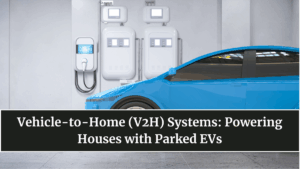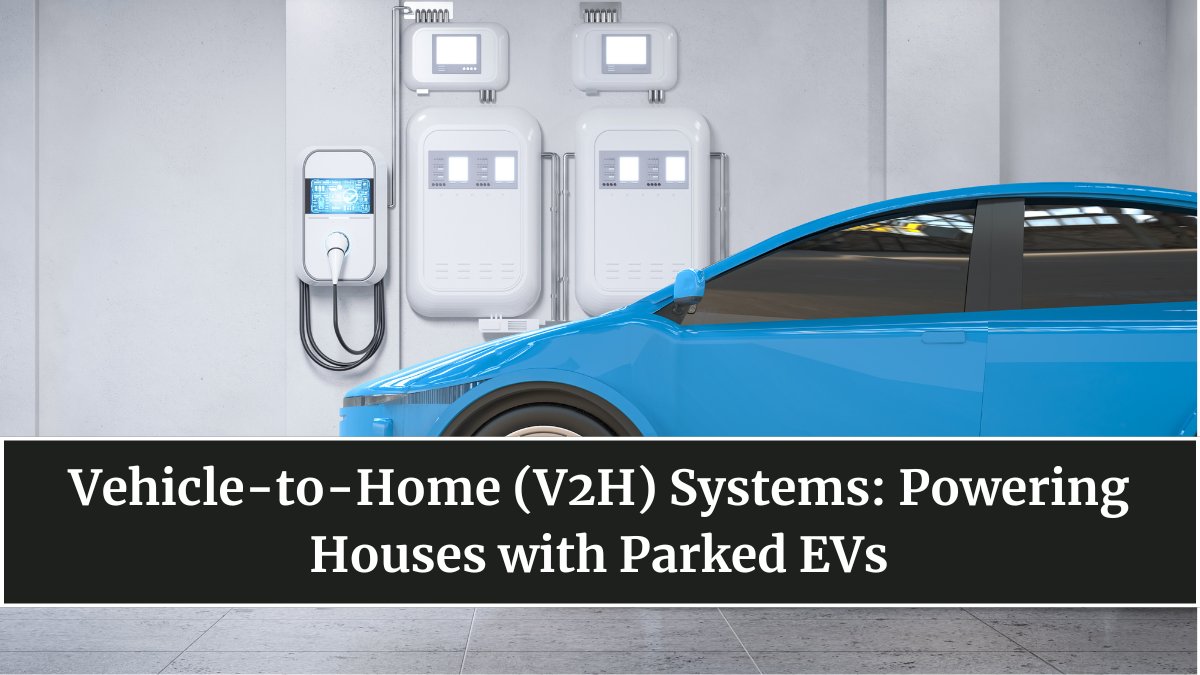Electric vehicles are no longer just a means of transportation—they’re becoming mobile power stations. In 2025, Vehicle-to-Home (V2H) systems are revolutionizing how households use and store energy. By allowing electric vehicles to send power back into homes, these systems transform parked cars into essential parts of the smart energy grid, providing backup electricity, reducing bills, and stabilizing renewable power flow.

What Are Vehicle-to-Home (V2H) Systems?
A V2H system allows an EV’s battery to discharge stored energy into a building’s electrical system when needed. Through bi-directional charging technology, the same charger that fills your EV battery can also feed electricity back to your home.
This innovation builds on Vehicle-to-Grid (V2G) concepts but focuses on localized use — directly benefiting the homeowner. Whether during power outages, peak energy demand, or nighttime use, the EV becomes an intelligent energy reserve that powers the household seamlessly.
How V2H Technology Works
V2H operates through bi-directional inverters and smart controllers that communicate between the EV, home, and utility grid. When your car is plugged in, it can automatically detect when the home needs extra energy — for example, during expensive peak hours — and supply power accordingly.
Key components include:
-
Bi-directional charger: Enables two-way electricity flow.
-
Smart energy management system: Optimizes when to charge or discharge based on time-of-use rates.
-
AI and IoT integration: Predicts household energy needs and weather conditions for renewable synergy.
This real-time energy balancing ensures maximum efficiency while extending battery life through optimized cycles.
Benefits of V2H Integration
The adoption of Vehicle-to-Home systems offers multiple economic and environmental benefits:
-
Backup power during outages: Perfect for areas with unreliable grids or natural disasters.
-
Energy bill reduction: Discharge stored energy during high tariff periods to save costs.
-
Better use of renewables: Store solar energy in your EV during the day and use it at night.
-
Grid stability: Prevents overload by balancing energy supply dynamically.
Countries like Japan, which pioneered V2H after the 2011 earthquake, have shown how it can serve as a lifeline during emergencies. Now, nations like India, the US, and the UK are rapidly adopting similar technologies as EV infrastructure expands.
Leading Automakers and Tech Providers
Automakers are integrating V2H capabilities directly into their latest models.
-
Nissan (with its LEAF and Ariya models) remains a global leader, offering home backup power systems in Japan and Europe.
-
Ford’s F-150 Lightning in the US enables households to run for up to 3 days on the vehicle’s stored power.
-
Hyundai and BYD are developing integrated smart home energy ecosystems combining EVs, solar panels, and battery storage.
Meanwhile, companies like Wallbox, Enphase, and Delta Electronics provide advanced bi-directional chargers compatible with multiple EV brands.
The Future of Smart Energy Homes
By 2025, V2H technology is becoming central to the smart home revolution. Integration with solar PV systems, home batteries, and AI energy assistants ensures complete energy independence. With governments offering incentives for bi-directional charger installations, more homeowners are seeing EVs as energy investments rather than just vehicles.
In the near future, your EV will not only take you places but also power your home, charge your neighbor’s devices, and support local microgrids. This synergy between mobility and energy marks a fundamental shift toward decentralized and resilient power ecosystems.
Challenges and Adoption Barriers
Despite its potential, V2H faces hurdles like high equipment costs, compatibility issues, and limited grid readiness in developing countries. However, rapid innovation and government support are bridging these gaps quickly. Global energy agencies predict a tenfold increase in V2H-enabled vehicles by 2030, driven by stronger battery warranties and standardized charger designs.
As costs drop and integration becomes seamless, V2H will soon be a standard feature in all EVs, turning every parked car into a silent powerhouse.
FAQs
What is a Vehicle-to-Home (V2H) system?
It’s a technology that allows EVs to send stored energy back into homes, powering appliances or acting as backup electricity.
How is V2H different from Vehicle-to-Grid (V2G)?
V2G sends power back to the utility grid, while V2H supplies power directly to your home for personal use.
Which car brands support V2H in 2025?
Nissan, Ford, Hyundai, BYD, and Kia are leading with built-in V2H capabilities in their EV models.
Can V2H reduce electricity bills?
Yes. By discharging during peak-rate hours and charging during off-peak periods, households can significantly cut energy costs.
What is the future of V2H systems?
The future includes AI-managed, renewable-integrated V2H homes, making EVs a vital part of sustainable and self-sufficient living.
